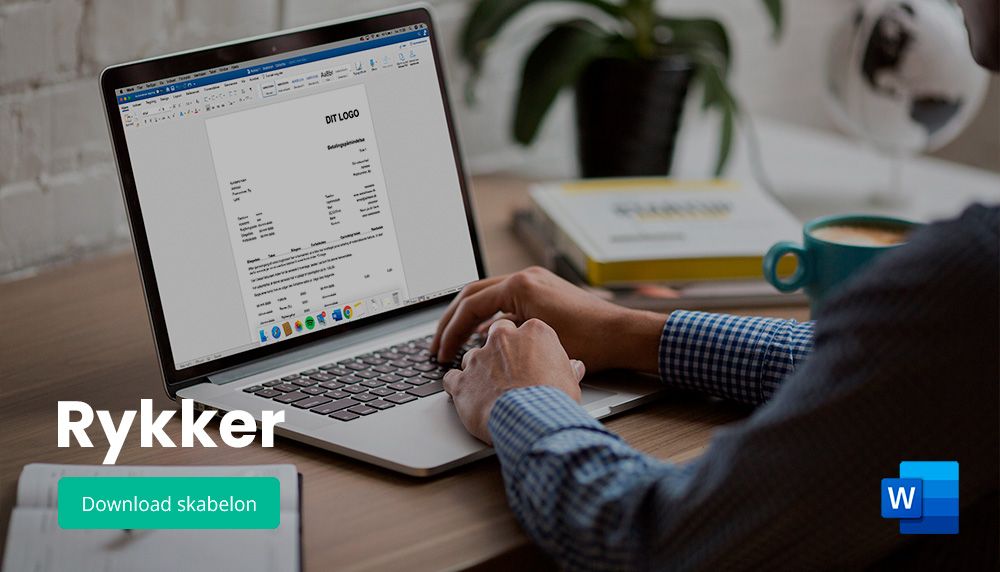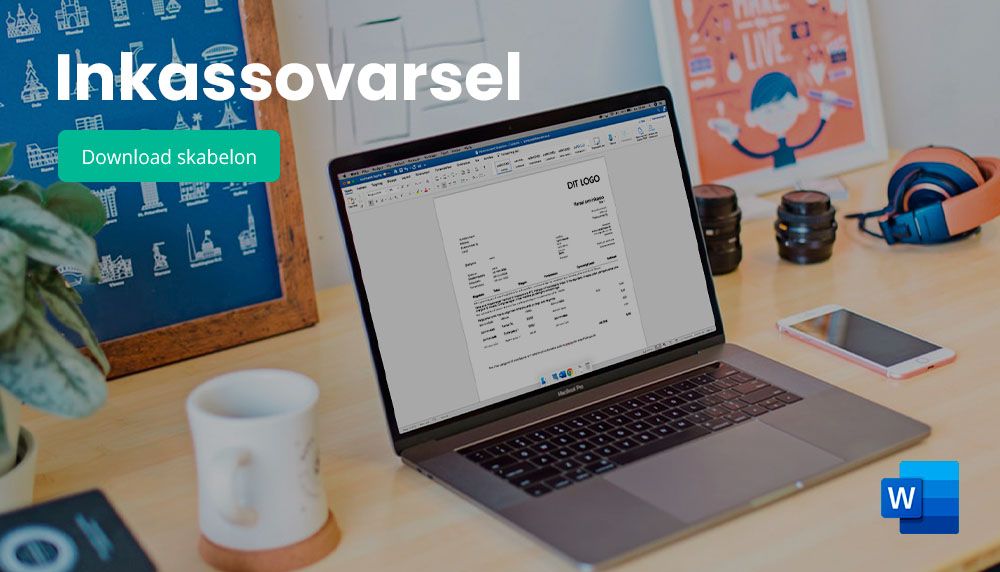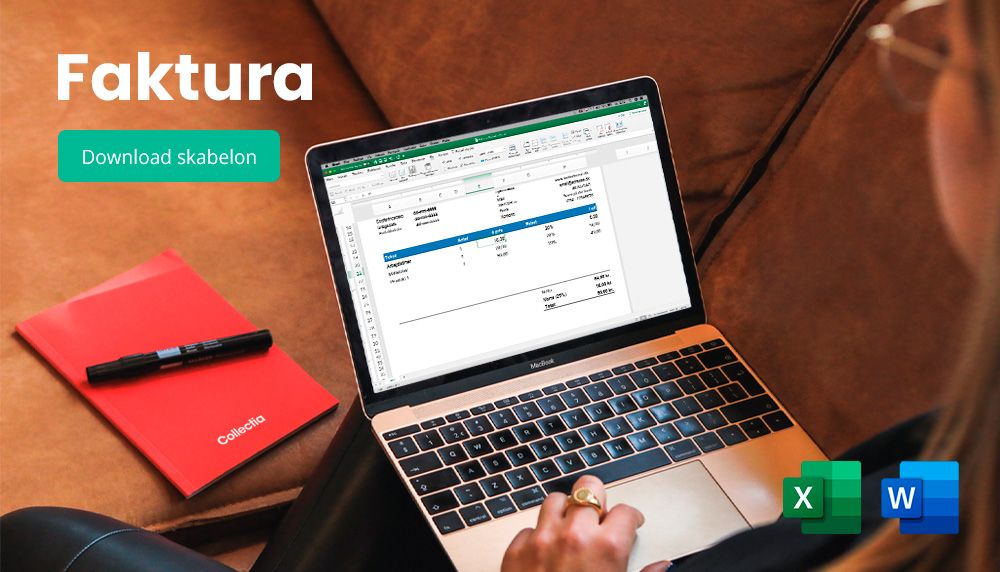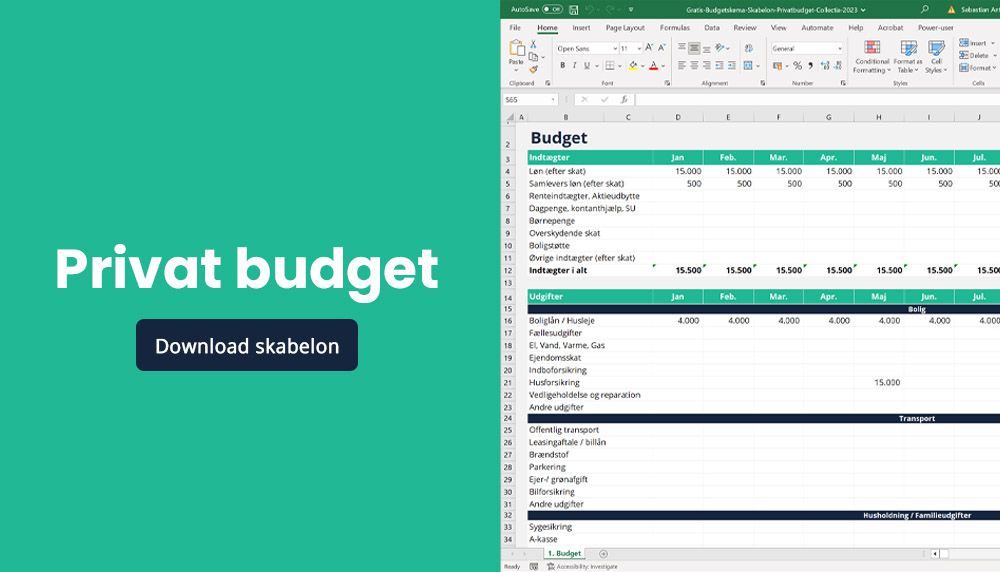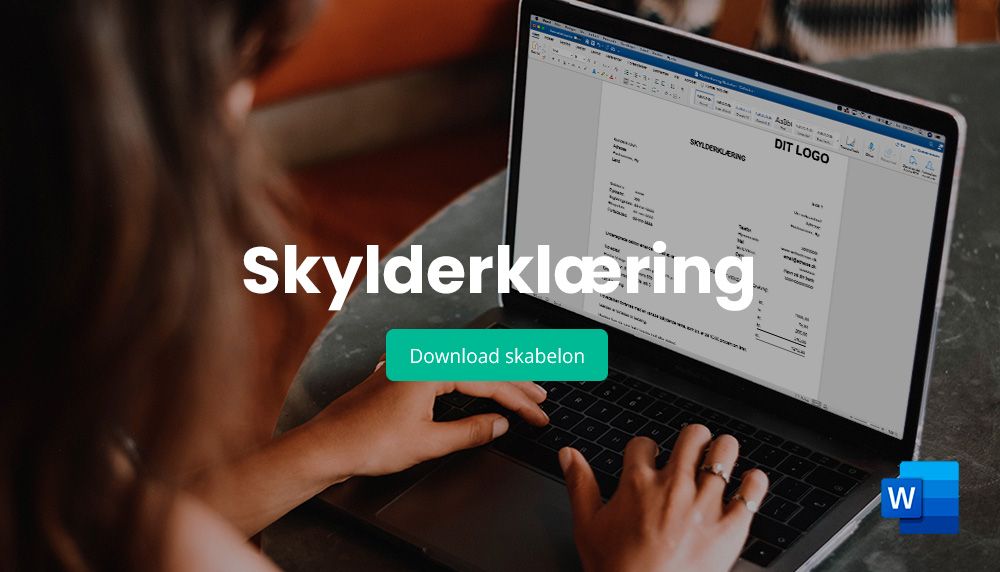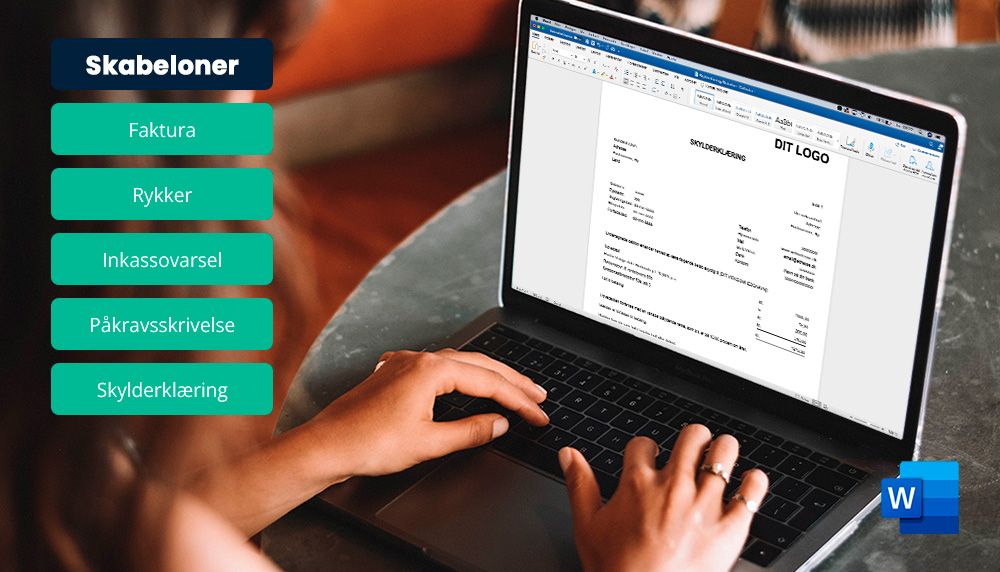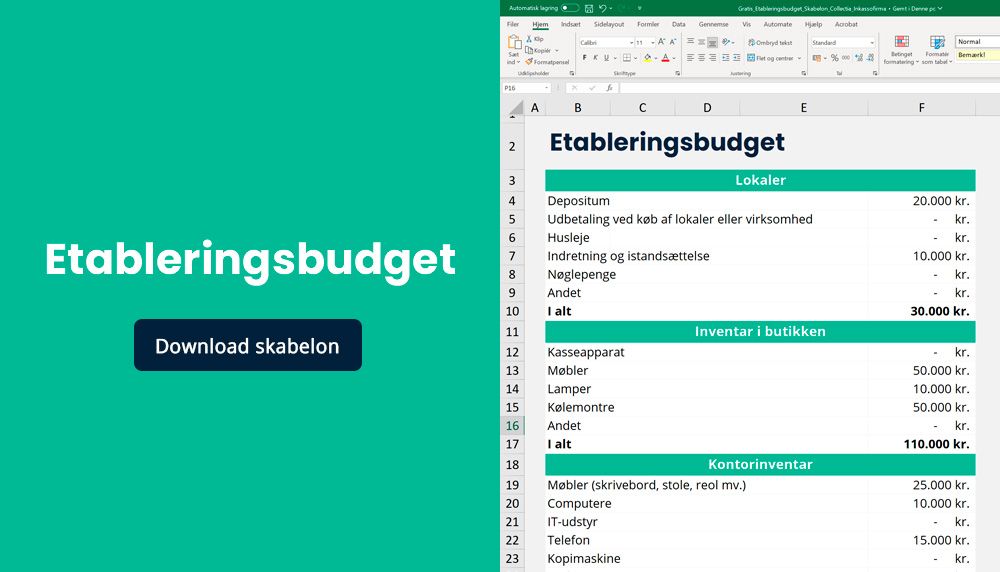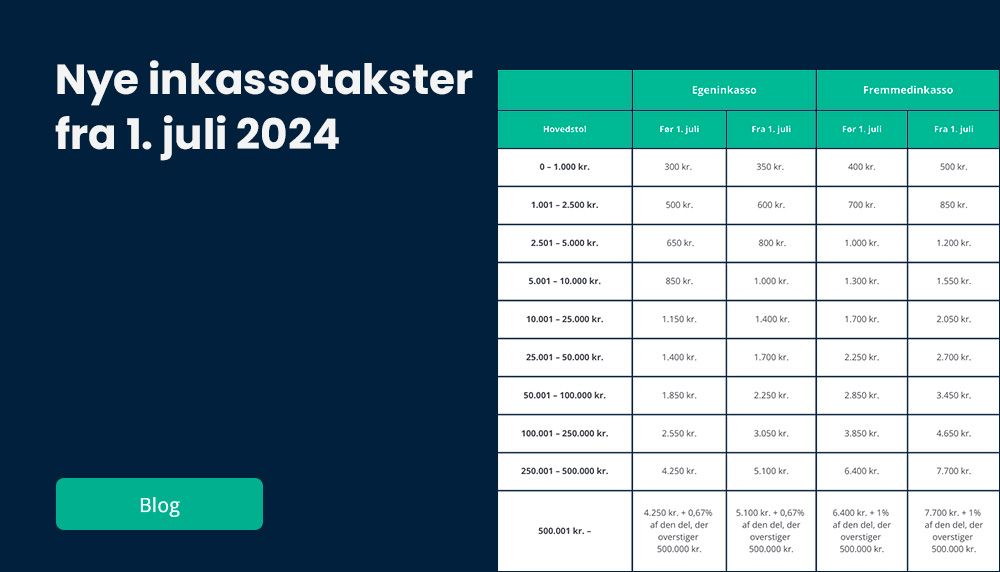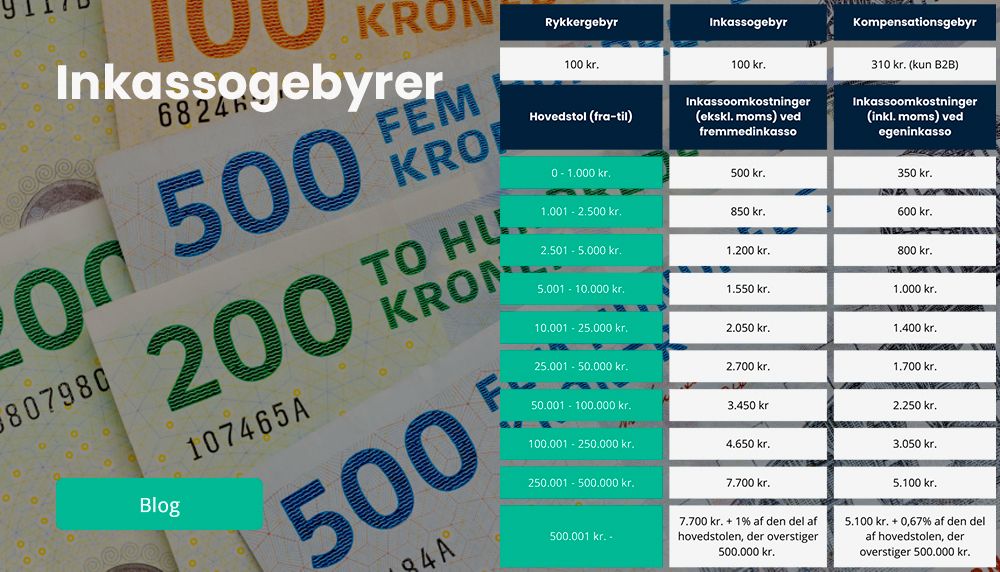FAQ - Frequently asked questions about debt collection
For many business owners, debt collection is something that hasn't been given much thought. But when the need for this service arises, it often raises questions. Here you will find the answers to some frequently asked questions we receive from our customers.
Debt collection
The cost of debt collection varies widely. Prices often range from "no cure, no pay" to a low price for a single case and all the way up to a subscription fee.
Typically, it's better to take out a subscription if you have many cases. On the other hand, it's often better to buy a single case if you only have 1-5 cases per year.
At Collectia, we have made it easy for all companies to get an overview of what debt collection costs. See our prices and structures here.
What are collection costs?
Collection costs are charged to the debtor and vary depending on the size of your claim. They are regulated in the Debt Collection Act. If the claim is between 0 and 1000 DKK, the collection cost is 500 DKK. But if the claim is between 1001 and 2500 DKK, the collection cost is 850 DKK. Thus, the collection costs increase gradually.
In addition to this, the debtor will typically be charged interest, reminder fees and possibly a compensation fee.
Who should pay the collection costs?
The debtor is liable for the collection costs, including interest, fees and compensation fees.
Thus, the debtor is also generally liable for the debt collection costs imposed.
How do you make money from a debt collection notice?
Collectia lives off the costs and fees we can impose on your customer.
If we start by sending a debt collection notice for you, we will charge your customer a fee of DKK 100. If we resolve your case, you will receive your full principal amount plus any fees we may charge.
Example
Principal (invoice amount): DKK 1200
Reminders (self-imposed): DKK 100
Collection notice: DKK 100
Total: DKK 1,400
Collectia recovers €1400 from your customer:
You get: kr. 1.300
Collectia earn: kr. 100
How do you make money in the debt collection process?
Collectia only earns money once we have resolved your claim. You will receive the full principal amount and any reminder fees we may charge when we resolve your claim. According to the law, Collectia charges your customer collection costs, which depend on the amount of the principal.
Example:
Your customer owes you DKK 1,800, you have sent 2 reminders subject to a reminder fee, where the last reminder reminder contains a debt collection notice. You transfer the claim to Collectia.
Principal (Invoice amount): DKK 1,800
Reminder (Own imposed fee): DKK 100
Collection notice (Own imposed fee): DKK 100
Collection costs: DKK 850
Total: DKK 2,850
Collectia collects DKK 2,850 from your customer:
You get: DKK 2.000
Collectia earns: DKK 850
We are as interested as you are in solving your case. If we don't solve it, we don't earn anything ourselves.
Can you help if I only have a few cases?
Yes, the number is not decisive. We can help even if you only have a single outstanding balance.
When a debtor is sent to debt collection, the debtor incurs additional costs in the form of interest, reminder fees and collection costs.
The debtor also risks receiving calls, being referred to the enforcement court and even being registered in Experian (RKI) or another similar debt register. If your case ends up in enforcement court, your assets may be seized and sold.
Another consequence of being registered in a debt register is often that you won't be able to take on new debt or take out subscriptions and the like.
What happens if I don't pay?
If you fail to pay your debt, the debt collection company or lawyer may choose to send your case to the enforcement court.
In the enforcement court, it is possible to seize your assets and have them sold. The sale of your assets will be used to cover the debt. Furthermore, you risk being registered in a debt register, which can prevent you from taking out bank loans, subscriptions or the like.
Why am I being sent to debt collection?
You are sent to debt collection if you do not pay a bill or invoice from a company. The collection process is handled either by the creditor themselves, the creditor's lawyer or a debt collection company on behalf of the creditor.
When is a bill handed over for collection?
A bill is sent for collection when it is determined that it has not been paid by the payment deadline. Companies have different procedures for when they send invoices for collection. Some send 1, 2 or even 3 reminders and a collection notice before the collection process begins. Others choose to send only a collection notice. Typically, most companies choose to turn over a bill for collection after 30+ days, provided they have sent a collection notice or had their lawyer or collection agency do so.
You can send your customer to debt collection when you have established that the customer has not paid within the agreed payment term and after sending a debt collection notice. It is essential that the payment deadline has passed and that you have sent a collection notice or demand letter giving the customer a minimum of 10 days to pay the debt. It is important to note that the claim must not be time-barred. As a rule, ordinary invoice claims become statute-barred after 3 years, but some claims may have a longer limitation period.
Can I send my customer to debt collection myself?
Yes, you can. But you must ensure that the customer has received a debt collection notice beforehand. You can either send this notice yourself, or you can let your lawyer or debt collection company do it for you. There are many ways to send a customer to debt collection. Typically, debt collection agencies offer online access, while others offer direct integration with ERP or accounting systems.
Who pays for the debt collection costs
The debt collection costs are charged to the debtor. It is thus the debtor who must cover these costs in the first place.
How does debt collection work?
The debt collection process can vary depending on which debt collection company or debt collection lawyer the creditor chooses. In general, the debt collection process consists of sending out reminder letters, demand letters, imposing interest and fees, following up by phone, offering installment plans and, in extreme cases, referring the case for legal proceedings in the enforcement court. In addition, the debtor may be registered in a debt register such as Experian (formerly RKI) or Debitorlisten.
Read more: Reminder process example
The price of a debt collection case can range from €0 to several hundred dollars. Some debt collection companies and lawyers operate on a "no cure, no pay" model, while others have fixed prices per case or offer subscription-based solutions. Prices and terms can vary considerably, so for an accurate price overview, we recommend you visit our website here.
Who pays for the collection fees?
Collection fees are generally charged to the debtor. It is therefore the debtor who must pay for the imposed expenses.
Are there any minimum amount requirements?
Although it is not a legal requirement to reminder a customer before starting debt collection, you must send a debt collection notice. This applies regardless of whether you as a creditor handle the debt collection yourself (self-collection) or let a debt collection company or lawyer take care of it. The debt collection notice must inform the debtor that if the claim is not paid within 10 days of sending the notice, a debt collection process will be initiated. Although this is a notice and not a reminder in the legal sense, you can still impose a reminder fee on the collection notice.
What does a reminder process look like?
The reminder process can vary, but often consists of one to three reminders at least 10 days apart. Each reminder must give the debtor at least 10 days to pay, and you can charge a reminder fee of DKK 100 per reminder. The reminders are often followed by a collection notice. Although the reminder process is optional, it does allow you to impose multiple reminder fees. However, each additional reminder will extend the waiting time before the collection process can be started. For example, three reminders plus a collection notice would mean up to 40 days from the missed payment deadline to collection. As a creditor, you should weigh the duration of your reminder process.
With no reminder fees, you can send as many reminders as you want.
How many reminders can I send?
There is no limit to the number of reminders you can send. However, if you impose reminder fees, you can only send up to three reminders with fees. Also, remember to allow at least 10 days for payment between each reminder.
No two debtors or cases are the same, and the same goes for debt collection.
The course of a debt collection case can vary considerably. Some cases are resolved at the first contact from the creditor or the creditor's debt collection company/collection lawyer, while others take months to resolve. Unfortunately, there are also debt collection cases that are never resolved, for example due to the debtor's death, bankruptcy or similar.
A typical debt collection case starts with the creditor or the creditor's debt collection company issuing a debt collection notice. The debtor is informed of the debt collection and typically has 10 days to pay the amount owed.
After the 10-day debt collection notice, many different steps can be taken, including sending reminder letters, imposing collection fees and interest, telephone contact, physical attendance, setting up an installment plan or transferring the case to the enforcement court to, for example, attach the debtor's property.
To understand what actions can be taken in your case, you can consult your debt collection company or debt collection lawyer.
How do I follow the recovery process?
As a customer, you get access to our Customer Web, which is of course also compatible on mobile and tablet. Inside the platform, you can create new cases, communicate with us and keep up to date on your debt collection. We also make our online platform, MitCollectia, available to your customers so they can also follow their cases, pay their debts and communicate with us.
Will it cost me anything if the debtor does not pay?
Basically, it will not cost you anything. It can only cost you money if you choose to take the case to court or if you choose to withdraw your case. If you withdraw the case, you will be liable for the costs that we have imposed on your customer.
We always recommend transferring cases to our monitoring process. Here, after the recovery process has been completed, we try to recover the money until the claim expires.
Can I close my debt collection case?
If you wish to close or withdraw a case that is, for example, in the out-of-court debt collection process, you will receive a charge. If you close the case, you will be liable for the costs that we have imposed on your customer. We therefore always recommend that you transfer the case to our monitoring process, where we try to recover the money until the claim expires.
Domestic debt collection, also often referred to as judicial debt collection, is when legal action is taken to recover a debt. This involves the help of the bailiff court.
Extrajudicial debt collection refers to the actions that a creditor or their debt collection company can take themselves without court intervention.
Most debt collection cases start as out-of-court debt collection, but can move to in-court/judicial debt collection if out-of-court debt collection is unsuccessful.
Judicial debt collection can lead to additional costs for the creditor, such as enforcement court fees. For this reason, many choose to either handle the matter themselves or seek help from a debt collection company.
As a creditor, you have the right to conduct debt collection yourself. In principle, a creditor has the same options as a debt collection company or a debt collection lawyer when it comes to debt collection.
However, many choose to use a debt collection company or a lawyer specializing in debt collection. This is partly due to the desire to save time and partly because an approach from an external party often has a greater effect than if the creditor makes the approach themselves.
Many companies also choose to handle parts of the dunning or debt collection process internally and then hand over the matter to an external party, such as a debt collection agency.
The purpose of a debt collection notice is to inform the debtor of an upcoming debt collection if payment is not made within a set deadline.
A debt collection notice contains information about the claim itself, its size, a payment deadline of at least 10 days and a notice that if the deadline is not met, the claim will be handed over to debt collection.
You can find more information about the content of the debt collection notice in the Debt Collection Act §10. We also offer a template for a debt collection notice here.
How do I send a debt collection notice?
It is recommended to send the debt collection notice either by letter or email.
If the debtor still refuses to pay after the reminder process has ended, you as a creditor can choose to initiate a debt collection process. This process starts by sending a debt collection notice to the debtor to warn them of an upcoming collection process. This can be handled either by the creditor themselves, a debt collection company or a lawyer.
There is no legal requirement to send reminders before a collection notice. However, it can be advantageous to send reminders first, both to add reminder fees and to send reminders for non-payment in a more accommodating way. Be aware that sending reminders with a fee may extend the time it takes to start the collection process, as these reminders require a 10-day payment deadline.
Basically, your customer has the payment term you set, whether it's for invoices or reminders. However, if you send reminders with a fee, you must allow at least 10 days for payment. A shortened deadline will invalidate the reminder and the associated fee. While it is possible to give a longer period than 10 days, it is not recommended.
Debt collection refers to the steps taken by a creditor or a collection agency/attorney to recover amounts owed. It typically relates to unpaid invoices between a customer and a company. A debt collection process is initiated after the creditor or their representative has sent a debt collection notice.
Who is allowed to collect debt?
In Denmark, only authorized debt collection companies and lawyers are allowed to assist other companies with debt collection.
The National Police in Denmark authorizes and approves debt collection companies. Currently, there are approximately 105 authorized debt collection companies, the majority of which offer debt collection services. However, there are some authorized debt collection companies that specialize in specific areas such as flight compensation and rent, and therefore do not offer general debt collection.
Although all lawyers in Denmark are allowed to assist with debt collection, not all want to offer this service. Lawyers who offer debt collection are often referred to as debt collection lawyers.
What does a debt collection process look like?
No two debt collection cases are the same, and the same goes for debt collection processes. Some debt collection processes can be long and involve many actions, while others are shorter and more direct. The common steps in a debt collection process include debt collection notices, reminder letters, phone calls, physical attendance, registration in a debt register, setting up repayment arrangements and, if necessary, legal action in cooperation with the enforcement court.
Modern debt collection companies, such as Collectia, are increasingly using AI to optimize the debt collection process. Collectia, for example, believes that a large number of actions are not necessarily efficient if the case can be resolved directly through the enforcement court.
Debt collection cases vary, and so do debtors. While some debtors pay after the first contact from a collection agency, other cases will never be paid due to circumstances such as bankruptcy or death.
A typical debt collection process may include: reminder letters, imposition of interest, fees, and collection costs, phone calls, personal visits to the debtor, setting up installment plans, registration in the debt register, and possible legal action through the enforcement court. In practice, debt collection companies can adapt their process based on the situation and may choose to skip certain steps if deemed unnecessary.
Anyone conducting debt collection activities in Denmark must comply with the principles of good debt collection practice described in section 9 of the Danish Debt Collection Act.
At the core of good debt collection practice is that the debtor must not be subjected to undue pressure, harm or inconvenience during the debt collection process. This practice ensures that the debtor is treated in an ethical, moral and respectful manner.
There are many legal decisions in this area that provide precedent and guidance on the subject.
Yes, there is a fundamental difference. While a debt collection lawyer often offers a wider range of services in addition to debt collection, a debt collection agency deals mainly with debt collection and related services.
For some, it may be crucial to work with a partner who focuses solely on debt collection, while others may see benefits in having their lawyer also handle debt collection for them.
Both the debt collection company and the debt collection lawyer have the same powers and perform essentially the same tasks in the debt collection process.
The debt collection company is authorized by the National Police, while a lawyer can work as a debt collection lawyer once they are licensed.
According to the Danish Bar Association's Law yer Key, there are approximately 100 debt collection companies in Denmark, while there are around 62 lawyers working with debt collection. Although all lawyers have the opportunity to work with debt collection, not all actively offer this service. The lawyers who focus on this area are often referred to as debt collection lawyers.
If you as a creditor do not want to handle debt collection yourself, there are several options for professional assistance. In Denmark, there are three main actors that can help with debt collection: authorized debt collection companies, lawyers specializing in debt collection and the enforcement court.
Both the debt collection company and the lawyer have access to the same tools and processes to assist with debt collection. The enforcement court, on the other hand, has the ability to take legal action, including seizing the debtor's assets. Therefore, a debt collection case can start with either a debt collection company or a lawyer and later involve the enforcement court. The bailiff court thus serves as one of the tools that both debt collection companies and lawyers can use.
When your customer raises a debt collection objection, you should immediately contact your lawyer or the debt collection agency handling the case for you. It is then sensible to comment on the objection and inform the lawyer or debt collection agency whether you wish to maintain the claim. It is essential that the objection is handled correctly. If the debtor still maintains the objection, it is possible to seek assistance from the civil court, which can decide on the objection. Always remember to inform your debt collection partner of any objections from the debtor before sending the case to debt collection. It is crucial that your debt collection partner is informed and has this knowledge. An objection is not a guarantee for the debtor; in some cases, it may result in additional costs for them.
The Debt Collection Act lays down the general rules for conducting debt collection activities. Associated with the Act are a number of related laws, including the Interest Act. The Debt Collection Act applies to debt collection companies that are not lawyers or banks. The law contains provisions on authorization, approval of personnel and general practice of debt collection. Although the entire law is relevant, section 10 is of particular importance for private companies and creditors who carry out debt collection themselves. This section deals with communication with the debtor and stipulates, among other things, that debt collection may only be initiated if a debt collection notice has been issued beforehand.
Although you may think the amount is too "small", we can help you. You've done a job, and whether your customer owes you £300 or £20,000, we can help you. Our philosophy is that your customers should be treated with respect and consistency.
Our concept means that we can easily handle your debt collection case regardless of the size of the amount.
Jerk
Basically, you can reminder a missed payment as many times as you want. However, it is a requirement that the payment has exceeded its payment deadline and that the claim is not time-barred. Typically, invoice claims expire after 3 years.
You can send reminders by phone, letter or the communication channels you have previously used with the customer.
If you choose to impose a reminder fee, you should send a maximum of three reminders with a fee of DKK 100 for each. It's also important to give the debtor a payment deadline of 10 days and to refrain from sending reminders in the interim period.
Although you can send multiple reminders, we recommend that you limit yourself to a maximum of three. A prolonged reminder process can delay the start of debt collection.
Ultimately, however, it is up to the individual company to decide how many times they want to reminder for non-payment.
Read more: Effective dunning procedure → How to get your customer to pay
A reminder letter contains information about the outstanding claim, including its size, what the claim is for (often referred to as an invoice number) and a payment deadline of 10 days.
Although there are no legal requirements for the form or text of the reminder, if you add a reminder fee, it is necessary to give the debtor at least 10 days to pay. We recommend that the reminder clearly states what it relates to, with a reference to the work delivered, product or invoice number.
When should I send a reminder?
It varies when you choose to send a reminder. We advise doing it 5-6 days after the missed payment deadline.
Time is of the essence in an effective dunning and collection process. The earlier you start, the greater the chance of resolution. A prompt response to a late payment demonstrates consistency to the debtor.
It is ultimately the creditor's choice when reminders are sent. Note that a payment made on the due date itself will typically not be visible to the creditor until 1-2 business days later.
For consistency, we recommend that companies systematize the sending of reminders so that they are sent with the same interval and regularity.
It varies when you choose to send a reminder. We advise doing it 5-6 days after the missed payment deadline.
Time is of the essence in an effective dunning and collection process. The earlier you start, the greater the chance of resolution. A prompt response to a late payment demonstrates consistency to the debtor.
It is ultimately the creditor's choice when reminders are sent. Note that a payment made on the due date itself will typically not be visible to the creditor until 1-2 business days later.
For consistency, we recommend that companies systematize the sending of reminders so that they are sent with the same interval and regularity.
The reminder process can vary from case to case, depending on whether the debtor pays, disputes the claim or otherwise. If the debtor neither pays nor disputes the claim after the first reminder, a typical reminder process will look like this:
- Day 1: Reminder letter 1 (possibly without reminder fee)
- Day 14: Reminder letter 2
- Day 28: Reminder letter 3
When sending out reminder letters with a reminder fee imposed, at least 10 days must pass between each one, as the debtor must have a payment deadline of 10 days. Even if the payment is made on day 10, it is still considered timely. If the debtor and creditor do not use the same bank, the transfer can take 1-2 business days. Therefore, it's a good idea to wait another 2-3 days before sending the next reminder.
A reminder, often also called a reminder letter, is a reminder from a creditor (or a debt collection agency) to a debtor that one or more invoices are unpaid.
The reminder is often sent physically on paper or digitally via email.
Although there are no formal requirements for a reminder, if a reminder fee is imposed, the debtor must be given 10 days to pay before a new reminder is sent. It is also possible to send reminders by phone for missing payments, but this is rarely referred to as a "reminder" in practice.
Up to 3 reminder fees of DKK 100 can be charged for each reminder.
What is a reminder fee?
A reminder fee is a fee that can be imposed on a reminder letter. It serves as compensation for the extra work it takes to reminder a debtor for payment.
To impose a reminder fee, the following criteria must be met:
- The reminder fee may not exceed 100 kroner.
- The reminder fee of DKK 100 can be charged a maximum of three times (i.e. 3 x DKK 100).
- The debtor must be given at least 10 days to pay the outstanding amount and the reminder fee.
If these conditions are not met, the imposed reminder fee is invalid. The reminder fee is not mandatory, but an option for the creditor.
What does a reminder letter contain?
A reminder letter describes exactly what the debtor owes and calls for payment of the principal and any reminder fee. Although there are no legal requirements for the wording, we recommend:
- That the dunning letter clearly specifies what is being dunned for, e.g. by referring to an invoice number.
- To provide a payment term of at least 10 days.
There are different ways to send a reminder. Although you can use the same communication channels as the order, we recommend sending reminders via physical mail or email. Many ERP and accounting programs allow you to send reminders electronically.
What does a reminder letter say?
As a creditor, you mainly determine the content of the reminder letter and there are no set requirements for the text. However, if you add reminder fees, the debtor must be given at least 10 days to pay. We advise to clearly show what the reminder letter is about, often an invoice reference is sufficient. Attaching the original invoice can be helpful, but is not mandatory.
As a creditor, you mainly determine the content of the reminder letter and there are no set requirements for the text. However, if you add reminder fees, the debtor must be given at least 10 days to pay. We advise to clearly show what the reminder letter is about, often an invoice reference is sufficient. Attaching the original invoice can be helpful, but is not mandatory.
You can charge a reminder fee up to three times. Always make sure to give the debtor at least 10 days to settle the amount owed and the reminder fee.
A reminder fee is a fee that you can impose on a reminder letter. The fee is set at DKK 100 and can be imposed on up to three reminders. It is a requirement that you give the debtor a payment deadline of at least 10 days from the date of sending.
When can I send a reminder letter?
You have the right to send a reminder as soon as it is established that a payment deadline has been missed. In practice, many people choose to wait a few days after the due date before sending a reminder.
What happens when my customer doesn't pay the reminder fee?
If your customer fails to pay the reminder fee, but only pays the principal, you can continue to claim the fee. However, in practice, many companies choose not to do this, but it is an individual assessment each company must make.
Court
Bringing a debt collection case before the enforcement court requires payment of a fee. In 2023, this fee is typically DKK 750. Be aware that your debt collection company or debt collection lawyer may charge additional fees, as sending a case to the enforcement court often involves extra work. Current prices for court fees can be found here. The amount must be paid upon submission of the case.
There are several types of enforcement proceedings, but the most common is the meeting where a creditor (or their collection agency) summons a debtor. This meeting is also referred to as a bailiff court meeting.
The debtor is summoned to the enforcement court if the creditor (or its debt collection company) has receivables from the debtor and wants the enforcement court's assistance in collecting the amount.
The bailiff generally has more powers than the creditor (or its debt collection company), such as making attachments, setting up installment plans or declaring insolvency.
The outcome of an enforcement action can vary, but often results in the creditor being able to extend the limitation period for their claim from 3 to 5 years.
Enforcement proceedings are often initiated after a prior debt collection process, even if it is not a fixed claim. Before enforcement proceedings can begin, the debtor must have received - and not paid - a debt collection notice. This notice can be sent by the creditor, a debt collection company or a debt collection lawyer.
What is a bailiff court?
The enforcement court primarily handles cases where a debtor owes money to a creditor. In these cases, the creditor or the creditor's debt collection company will typically be the counterparty.
You can find the bailiff court in one of the more than 24 local district courts located in major Danish cities.
The creditor has the option to request the bailiff to summon the debtor to the bailiff court. The purpose of this is to resolve one or more unpaid financial matters.
The bailiff is the only authority in Denmark that has the power to attach the assets and property of others in connection with debt collection. This is an essential tool in the debt collection process against a debtor.
When a debtor has not paid one or more claims from a creditor, the creditor (or their debt collection company/lawyer) can seek help through the enforcement court. At the request of the creditor or their representative, the bailiff court will summon the debtor to a bailiff court meeting.
At the bailiff court meeting, the debtor will be physically summoned and both the debtor, the bailiff and the applicant will be present. The applicant can be the creditor, the creditor's lawyer or a debt collection company. Some petitioners participate by phone or online.
During the meeting, the bailiff will inform the debtor of their obligation to truthfully disclose their financial circumstances. Then the bailiff will often ask if the debtor has the means to pay the creditor's claim immediately.
The creditor will then ask about the debtor's financial situation and any valuable assets such as a car, boat or real estate. If the debtor owns such assets, the creditor can request an attachment of these. However, no attachment will generally be made if the debtor can offer an installment plan over a maximum of 10 months.
If the debtor can neither offer a repayment plan nor has assets of value, an insolvency declaration can be requested, after which the debtor will be protected for 6 months.
A typical bailiff court meeting usually lasts between 10-15 minutes.
At a bailiff court hearing, there are usually three parties present: the bailiff, the debtor and the petitioner. The petitioner is the party who has called the bailiff's meeting and can be either the creditor themselves or a third party assisting the creditor with debt collection - typically a debt collection company or a lawyer.
The debtor must generally appear in person at the enforcement court. The creditor's representative will also usually be physically present, although participation can also be done online or by phone.
If a debtor fails to attend a bailiff court meeting without prior notice, they risk being picked up by the police and brought to the bailiff court.
A fee is charged for sending a case to the enforcement court.
When a debtor owes money, it is the debtor who must cover the costs of the case. These costs can include court fees as well as any fees imposed by the creditor.
The amount of costs for the debtor is determined by the enforcement court and often depends on the amount of money owed.
A court fee is a fee paid to the court and collected on behalf of the state.
Generally, a court fee is charged for all civil cases, however, certain cases are exempt, such as custody, marriage and paternity cases.
The amount of the court fee is determined by the courts and is based on the financial scope and value of the case.
For cases under DKK 100,000, the legal fee is DKK 750 (based on 2023 rates). For cases above DKK 100,000, the legal fee is DKK 1,500 (also based on 2023 rates).
For cases without financial value, the court fee is DKK 750 (2023 rate).
The current court fees can always be found at domstol.dk.
As a rule, the debtor must cover the costs and court fees imposed by the enforcement court.
If a debtor cannot pay the amount owed in full or offer an installment plan that can be completed within a maximum of 10 months, the creditor (or the creditor's lawyer/collection agency) can request the enforcement court to seize the debtor's assets.
The enforcement court can generally seize anything that is of significant value to the debtor, such as real estate, valuable art, expensive assets, cars, boats, etc. The enforcement court can also seize the debtor's deposit if they are renting.
When the enforcement court attaches the debtor's assets, a principle of "trangsbeneficium", also known as "modest home" or "modest living", is applied. A "modest home" typically includes items and assets that one would expect to find in an ordinary home, such as a cell phone, a TV and other furnishings of modest value.
The enforcement court should avoid seizing assets that could be considered part of a "modest home" or "modest living" unless the value of a particular asset is so high that it exceeds what would typically be found in a modest home. Examples could be very expensive watches or high-end televisions.
The rules for attachments can be found in sections 510-516 of the Danish Administration of Justice Act.
There are several ways to handle debt collection: the creditor can either choose to handle the debt collection themselves, often referred to as self-collection, let a debt collection company or their lawyer help with debt collection, often referred to as third-party debt collection, and finally, the creditor can ask the enforcement court for help with debt collection.
Debt collection with the help of the enforcement court is commonly referred to as judicial debt collection.
Debt register
For invoice claims where a single invoice is the basis for documenting the outstanding amount, at least three reminders must be sent before the case can be registered with a debt register, such as RKI or Debitorlisten.
These reminders must follow the requirements for reminder letters, including a minimum of 10 days between reminders. There is no requirement for reminder fees to be applied.
In the final reminder letter, the debtor must be informed about the upcoming registration in the debt register.
The amount owed must be at least DKK 200 and the claim must not have been disputed by the debtor.
How much time should elapse between reminders?
When sending reminders with a reminder fee, you must allow at least 10 days between each reminder. It's important to highlight on the reminder that the debtor has a 10-day payment period to cover both the main claim and any reminder fee.
In principle, without a reminder fee, there is no fixed limit to how often you can reminder the debtor. However, we advise not to shorten the interval below 10 days between reminders.
Debt collection refers to a series of steps that debt collection companies, lawyers or creditors themselves can take to recover an unpaid claim.
The debt collection process may include the imposition of fees, phone calls to the debtor, written inquiries, setting up installment plans, etc.
RKI or other debt registers can be used as a tool in the debt collection process. Being registered in RKI can have significant consequences for a debtor's future financial situation, including loans, subscriptions and other situations involving credit ratings.
RKI is an abbreviation for Ribers Kredit Information. It is a debt register in Denmark where both private individuals and companies with outstanding debts are registered.
The company Experian owns and operates RKI.
Many companies use RKI to check the creditworthiness of both private individuals and other companies. If you are registered in RKI, it can affect the conditions under which you can do business with a company.
How do you get out of RKI?
You will be removed from RKI as soon as you as a debtor have paid your debts. If the debt is not paid within 5 years, the registration is automatically deleted. After this period, the debtor is no longer registered in RKI for the debt in question.
A debt register is a record of those who are struggling to pay their debts. Both private individuals and companies can be listed in such registers.
The purpose of a debt register is to inform others that a particular person or company has outstanding debts. Debt registers are often used in credit assessments of potential customers. This can be done by companies, banks or other stakeholders who want a long-term relationship with the customer, such as subscription services or telecom companies that provide continued service.
You are typically registered in a debt register until the debt is paid off, or for a specific period of time, usually 5 years.
As a general rule, cases with an amount over DKK 200 can be registered in RKI and similar debt registers. However, in order to be registered in RKI, the debtor must have received at least three reminders, the last of which must inform about possible RKI registration in the event of non-payment.
In addition, the debtor must not have disputed the debt claim in order to be registered in RKI.
Cases regarding debts to insurance companies and banks must have been processed in civil court or enforcement court before any registration in RKI.
Public authorities can register debts if the amount exceeds DKK 7,500, provided the debtor has been given at least 4 weeks' notice.
